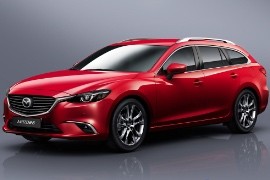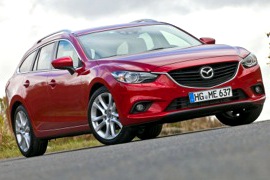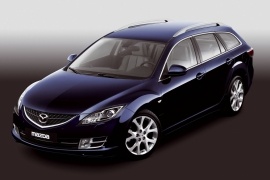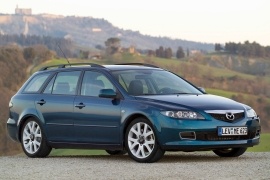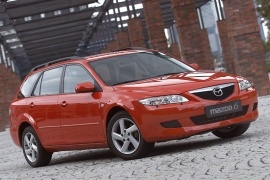MAZDA 6 / Atenza Wagon Models/Series Timeline, Specifications & Photos
First production year: 2002
Engines: Gasoline, Diesel
Body style: Wagon (station wagon, estate, combi, touring)
The third generation of Mazda 6 was launched in 2012 both as a sedan and station wagon. It stunned the world with its beauty and, in 2016, a mid-life cycle refresh was up on the market.
It is very hard to enhance visually a vehicle that was acclaimed for its look, and the design seemed to look brand new even after 4 years. Mazda had this situation when it had to rejuvenate its top model, the large model 6. But it had to and the most important elements that it changed were under the hood. On the outside, there were few subtle modifications, such as the turn signals from the exterior rearview mirrors. On the facelifted version thee were horizontal instead of vertical. The grille had a 3D pattern, like a mesh with diamonds on it.
Big enhancements were to be found inside the cabin, where the dashboard was more driver-oriented. A head-up display was added to the features, a new steering wheel and better materials were used. Also, a 360 degrees camera system was included in the options list.
A new system was installed in the car, to enhance cornering speed. When cornering, a slight brake is applied on the inside wheels and on the exit the torque sent to the wheels is amplified.
Thus, the car will handle better on bends. It is something that good drivers do: slight brake before the turn and throttle after the apex. But Mazda's technology is better since it brakes only the inside wheels. Most of the engines and transmissions are carried over from the non-facelift model.
After Mazda got away from Ford Motor Company, it started to do vehicles like they wanted to do. And this is how the 2013 Mazda 6 came on the market, at the Moskow Motor Show in 2012.
It was big, spacious and with a lot of flowing lines on the bodywork. Even the station wagon version, which was launched at the Paris Motor Show in the autumn of 2012, had the same curves all over the place. While the form was the same from the bumper to the B-pillar, from there on it was a different car. The roof was extended and, after the rear seats, started to descend and it ends the car in a nice, rounded, tailgate.
Inside, there was plenty of room for five passengers. The driver had a classic instrument cluster with analog-dials. On top of the center console, easy to reach by the driver, there was the infotainment system equipped with a touch-screen display. It could have been upgraded to a Bose premium sound system. But, even in the base trim level, it offered a good sound experience, Bluetooth connectivity, and cruise control. The seats were bolstered, but not that much as a bucket seat. The trunk space was big, with a standard 522 liters (18.4 cu-ft), which could have been extended up to 1664 liters (58.7 cu-ft).
The wide range of engines and transmissions also included an all-wheel-drive system. The all-wheel independent suspension offered a great level of comfort.
Mazda followed Ford's ideas to build three body shapes on the same mid-size sedan platform and offered the 6/Atenza station wagon.
Ford owned a big chunk of Mazda since 1996, and as part of the plan was sharing platforms and engines between the brands. That's why the Mazda 6 received the Mondeo's platform, and it was a good move. The Japanese carmaker was known for its sporty products, starting whit the best-selling roadster globally, the MX5. On the other hand, it needed to sell vehicles for all Joes and Janes, and a station-wagon was the ideal solution for a young family who didn't like the MPVs.
Mazda designers decided to combine curved lines and sharp angles. The front wheel-arches were enlarged, and the swept-back headlights evoked the samurai warrior eyes. Its sweeping, V-shaped pentagonal grille enhanced the sporty look of the vehicle. Despite being taller, wider, and longer than its predecessor, it was lighter by 35 kg (77.2 lbs) on a similar trim level. In station wagon form, the 6/Atenza was slightly longer than its sedan and hatchbacks siblings.
The interior was large and comfortable for four adult passengers. While the front bucket seats featured average-height bolstering, the split-folding bench in the back featured three headrests. Depending on the trim level, Mazda installed a Bose sound system and a sat-nav.
Under the hood, Mazda installed a wide range of engines. For starters, a 1.8-liter was considered good enough, mostly for fleet use. Depending on the market, the 6 offered a Ford-sourced 2.0-liter turbodiesel. Due to its independent suspension in all corners, it offered good handling and comfort.
The 6/Atenza was introduced for the first time in 2002 and, by 2005, it was already an established car on the market. But Mazda decided to give it a facelift to keep it up to date.
The Mazda 6 bears the name Atenza on some markets, but it was the same vehicle. It was offered in three body versions: sedan, hatchback, and station wagon. The facelift occurred in 2005 affected all three of them and brought new engines to comply with the latest emission standards in Europe and new features onboard.
From the outside, the look resembled the tuning community with its clear headlights and four round lamps inside. Its sleek, curved look with sharp angles between the lines made it a distinct car for the new-edge design trend. It was normal since Ford launched the trend, and Mazda was a Ford Motor Company member. The extended roof for the station wagon didn't make the impression of a utility vehicle, such it was the VW Passat, but more like an extended hatchback with a less raked tailgate. The taillights followed the same design idea as the headlights.
Inside, the sporty feeling was amplified by slim metallic trims around the black interior panels. The round air-vents and the four-round analog dials in the instrument cluster confirmed the car's sporty character. There was plenty of room in the back for up to three passengers, and the trunk was good for its class. But it wasn't designed as a utility vehicle.
Under the hood, the 6/Atenza Wagon featured a choice of diesel and gasoline engine, either developed by the Japanese company or by Ford. Some of them were available with automatic transmission.
The 2002 Mazda medium-sizes sedan was a design hit. Even when it was replaced by a new generation its body didn't look old. Even some newer vehicles looked older than the Mazda6/Atenza. The sharp design, sporty look and three choices of bodywork helped the car be well received by customers around the world. A wide engine range could satisfy most of the mid-size car market customers.
The platform used on the 2002 Mazda6 was actually used for more vehicles from the Ford Motor Company, since at that time Mazda was into a partnership with the American company. Ford Edge, Lincoln MKX and Zephyr or the CX9 SUV from Mazda were built on the same architecture, with an all-wheel independent suspension and choices for all-wheel-drive or front-wheel-drive. That said, most Mazda6s had front-wheel-drive. Engines varied from a 1.8-liter with 125 hp up to a 220 hp from a 3.0-liter V6 in some markets. The transmissions offered were either five or six-speed manuals. For the automatic versions, there were four or five speeds available, depending on the engine.
The Mazda 6 was available in few trim levels, with specific options installed. Top versions had a sat-nav system, Bluetooth connectivity, and a Bose sound system. Bucket seats were installed on sportier trims, but even the standard ones were good for holding their occupants in place while cornering.
